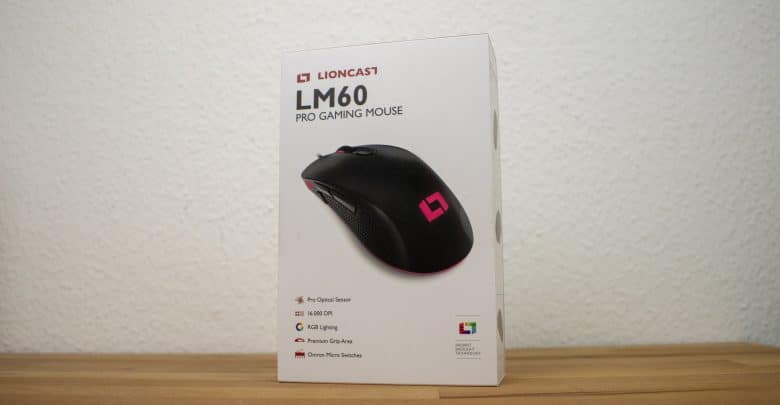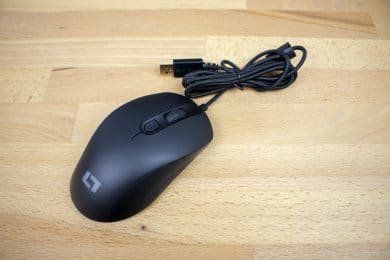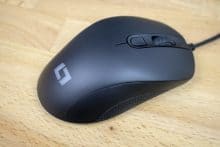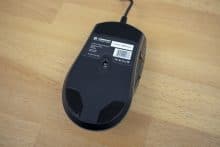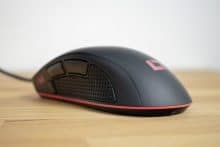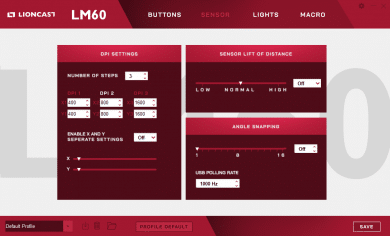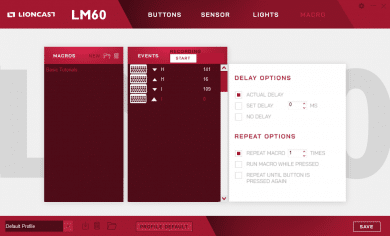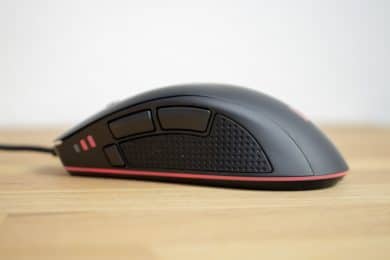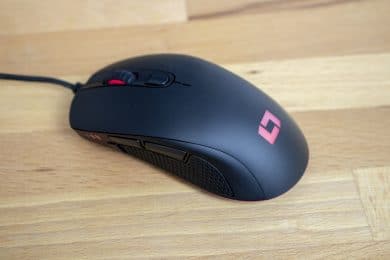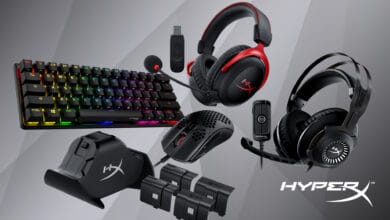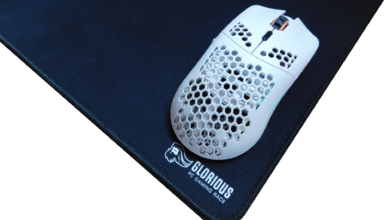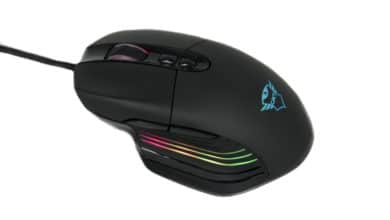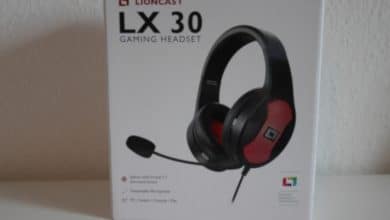Lioncast, a comparatively young manufacturer, recently added a new gaming mouse to its portfolio that will be in the upper price and quality class. We have now had the pleasure of testing the device quite early on. The following lines are intended to provide a little more information about the LM60, its suitability for practical use and our opinion of it.
Scope of Delivery
The small package does not contain much, which is not surprising. A mouse is easy to operate and takes up very little space. Next to the mouse, on which the permanently installed cable hangs, there is only a small card in the box. On this map you will find the address of the website where you can download the software required for individualised operation. So there are no surprises.
Technical Details
| Ergonomics: | Right-handed |
| Sensor: | optical PixArt PMW-3389 |
| Resolution: | 100 – 16,000 DPI 4 levels |
| Sampling rate: | 1,000 Hz |
| Primary switch: | Omron button, 50 million clicks |
| Number of keys: | 7 |
| Special keys: | DPI selector switch |
| Software: | 5 profiles, completely programmable, macro recording |
| Lighting: | Color: RGB, 5 zones DPI indicator |
| Housing: | 125 × 68 × 39 mm Hard plastic, coating Rubber elements |
| Weight: | 105 gram (without cable) |
| Connection: | USB cable, 2.00 m, wrapped |
| Price: | € 34.95 * |
Design and Workmanship
Unpacked, the mouse looks simple and unobtrusive. It is relatively small and with a weight of about 105 grams quite light. We noticed the three additional keys on the left side positively, all of which are very easy to reach. The structure of the mouse seems to be very well planned and thought through. It lies well in the hand, all keys can be reached without any distortion and the mouse looks very well processed overall.
Also optically we have nothing to criticize at the mouse. It is kept in plain black and is hardly noticeable. With this timeless design, we believe Lioncast has made an excellent choice. The mouse blends easily into the environment and is probably compatible with any other equipment. Had more striking colours or other striking design elements been chosen, this would probably not have been the case. So Lioncast made a wise decision.
Thanks to the individually adjustable RGB lighting, the colour of the mouse can also be adapted to your own wishes. Both the prominently placed manufacturer logo and a light ring at the bottom of the mouse and the DPI display on the side are illuminated. In total, there are four lighting zones and the DPI indicator, whose color can also be changed.
Software
Before using the mouse, take a look at the software. Here you will find numerous possibilities to adapt the device to your own needs. In the test we noticed the software very positively. Although it offers relatively many possibilities, it remains slim and clear. We could immediately find our way around here and found all the settings in no time. At first, macro and recording settings can be made under the item “Macro”. Under the menu item “Buttons” it is possible to assign the keys according to your own wishes. Various sensor settings can be made under “Sensor”. In addition to adjusting the three DPI steps, it is also possible to adjust the lift-off distance, the angle snapping and the polling rate. If the item “Lights” is called, the RGB lighting of the mouse can be adjusted. There are an incredible number of colours and options to choose from.
Thus, the mouse can be adapted both technically and optically relatively freely, which is a big advantage. The clarity of the intuitively operable software also represents an advantage.
Practice Test
In the practical test, it was initially noticed positively that the mouse lies very comfortably in the hand and can be operated without any problems. Thanks to its light weight and optimized construction, it glides very well over the mouse pad, all keys are easy to reach and the mouse’s center of gravity appeal was good.
We also noticed the pressure point of the switches positively. They could be operated perfectly in the practical test and did not cause any disturbingly loud noises. The DPI resolution is adjustable in three steps. The default values are 400, 800 and 1600 DPI. However, the values can be changed in the software at will. The maximum possible DPI value is 16,000, making it possible to adapt the resolution of the sensor to one’s own requirements and to various applications and games that often require different sensitivities and resolutions. In practice, we succeeded very well. The PixArt-PMW3389 sensor proved to be of high quality in every respect in the test. The excellent responsiveness increases the game fun enormously.
Furthermore, the LM60 convinces with its mobility, which also results from the low weight and the overall very light construction. All in all, the mouse is very well suited as a gaming mouse – also thanks to the many individual setting options.
Conclusion
Altogether Lioncast presents the LM60*, a good gaming mouse, which convinces optically by its simplicity and technically by its excellent Pixart sensor. Thanks to the individually adjustable RGB lighting, it can also be adapted optically to your own wishes.
At the technical level, various setting options are also available. The software required for making these settings is very clearly laid out and easy to use. Overall, it is a solid gaming mouse. The price of 70 Euro can be described as reasonable, even if some devices with comparable equipment are a little cheaper to have.
Lioncast LM60
Workmanship
Features
Software
Ergonomics
Value for Money
A good and recommendable gaming mouse.
